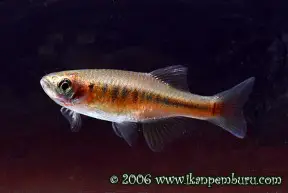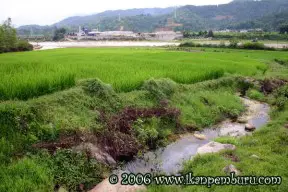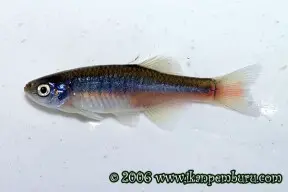Devario apogon
SynonymsTop ↑
Danio apogon Chu, 1981
Etymology
Devario: appears to be derived from a local vernacular name for the type species of the genus Cyprinus (now Devario) devario Hamilton, 1822.
apogon: from the Ancient Greek a-, meaning ‘not, without’, and πώγων (pogon), meaning ‘beard’, in reference to this species’ lack of barbels.
Classification
Order: Cypriniformes Family: Cyprinidae
Distribution
Type locality is given as ‘Jiucheng, Yunnan Province, China’ which could refer to one of several places with the same name in southwestern Yunnan.
It’s also been collected in Tengchong and Lianghe districts, Yingjiang county, and all known localities are within the Daying river (Dayingjiang) watershed, a major tributary of the larger Irrawaddy/Ayeyarwady river system.
Fang (200) states that it may also occur in northeastern Myanmar.
Habitat
Inhabits larger rivers, tributaries, streams, and even ditches and is apparently abundant across its known range. Water may be clear or turbid and flow over substrates of mud, gravel, sand, and exposed bedrock.
It’s clearly an adaptable fish as evidenced by the fact that over the course of March and April 1995 it was recorded from a polluted stream surrounded by intensively-farmed rice fields, a clear water river flowing swiftly over gravel, and a slow-moving roadside stream with clear water.
It’s been collected from the type locality of Dario dayingensis, which comprises a small (~ 2 m wide), shallow (< 30 cm deep) stream running through agricultural land at just over 900 m AMSL.
The water flows quite swiftly over a substrate of rocks, sand, leaf litter and mud, and from photos it appears that marginal vegetation provides a degree of cover.
Several other fish species were found to occur at this locality including Lepidocephalichthys berdmorei, Dario dayingensis, and Channa gachua, plus the introduced Rhodeus sinensis, Abbottina rivularis and poeciliid Gambusia holbrooki.
Maximum Standard Length
40 – 45 mm.
Aquarium SizeTop ↑
An aquarium with base measuring 80 ∗ 30 cm or equivalent should be the minimum considered.
Maintenance
No information regarding captive care exists but presumably it won’t prove difficult to keep in a well-maintained set-up as with related species.
It’s likely to thrive in an aquarium set up to resemble a flowing stream or river with a substrate of variably-sized, water-worn rocks, sand, fine gravel and perhaps some small boulders.
This can be further furnished with driftwood roots or branches, and while the majority of aquatic plants will fail to thrive in such surroundings hardy types such as Microsorum, Bolbitis or Anubias spp. can be grown attached to the décor.
Since it naturally occurs in pristine habitats it’s probably intolerant to accumulation of organic pollutants and requires more-or-less spotless water in order to thrive.
Though very fast flow is unnecessary it should also prefer a relatively high proportion of dissolved oxygen and moderate water movement.
Weekly water changes of 30-50% tank volume should be considered routine, and the tank must have a very tightly-fitting cover as all Devario spp. are accomplished jumpers.
Water Conditions
Temperature: It is subject to seasonal temperature fluctuations in nature and should be comfortable within the range 15 – 24 °C.
pH: 6.0 – 7.5. At the locality described above the pH was 6.2 in July 2006.
Hardness: 18 – 143 ppm
Diet
Almost certain to prey chiefly on insects and their larvae in nature and likely to prove an unfussy feeder in captivity.
A good quality dried product can be used as the staple diet but this should be supplemented with regular meals of small live and frozen fare such as bloodworm, Daphnia, Artemia, etc., for the best colouration and conditioning.
Behaviour and CompatibilityTop ↑
Not known at this time, but unlikely to prove aggressive. As with other members of the genus a group of 6 or more should be the minimum purchased.
Sexual Dimorphism
Sexually mature females should be rounder-bellied, less colourful and a little larger than males.
Nuptial individuals of both sexes take on an orange-red colouration, especially in the lower portion of the body, and the darker elements of the colour pattern become more intense in males.
NotesTop ↑
This species is more-or-less unheard of in the aquarium hobby at time of writing and has yet to be exported as far as we know.
It’s distinguishable from similar-looking congeners by a combination of characters as follows: : presence of narrow, indistinct vertical bars on anterior portion of flank, with a wide, tapering horizontal P stripe in the posterior, terminating at the caudal peduncle; barbels absent; lateral line absent.
In recent years it’s become commonplace to refer to the stripes on the body and fins of danionins as follows:
– P stripe: or ‘pigment stripe‘ is the central, dark, lateral stripe on the body which extends into the caudal-fin in some species. Stripes above it are numbered P+1, P+2, etc., and those beneath P-1, P-2, P-3.
– A stripe: the central stripe on the anal-fin; the proximal stripe (above it) is A+1 and the distal stripe (beneath) A-1.
– D stripe: The submarginal dorsal-fin stripe.
Following Fang (2003) Devario spp. are characterised by: possession of a P stripe extending onto the median caudal-fin rays; a short maxillary barbel (absent in some species); absence of the A stripe (a less distinct, relatively wide stripe is present in some species, e.g., D. acrostomus, D. annandalei, D. xyrops); a short, wide premaxillary process (cleft in the upper jaw) with a tiny apophysis (bony tubercule) touching the kinethmoid bone; infraorbital 5 not or slightly reduced.
The current genus name has only been in general use since 2003 prior to which members were considered to belong to the genus Danio.
Older, molecular, phylogenies tended to agree that the latter represented a monophyletic group consisting of two major clades; the ‘Danio devario‘ group containing the larger, deeper-bodied species and the ‘D. rerio‘ clade comprising the smaller, slimmer fish.
However in 2003 Fang Fang conducted a more detailed study based on morphological characters which included members of other related genera, and the results suggested for the first time that the genus Danio as previously considered represents a polyphyletic grouping, i.e., not all members derived from a single common ancestor.
The genus name Devario was suggested for the larger species with Danio being applied only to the smaller fish, although following Kottelat (2013) the latter should be used only for the type species, Danio dangila, with most former members placed within the revalidated genera Brachydanio and Celestichthys.
These results have largely been supported by subsequent phylogenetic analyses (e.g. Mayden et al., 2007), although Devario has still undergone a little reshuffling, particularly following Fang et al. (2009) and Kottelat (2013).
In the former study the two species previously comprising the genus Inlecypris were brought into synonymy with Devario and three species formerly included in Microrasbora were moved into the new genus Microdevario based on possession of shared synapomorphies with Devario. The existence of a monophyletic clade consisting of the genera Devario, Chela, Laubuca, Microdevario and Microrasbora was also hypothesised, a theory upheld in the more recent study by Tang et al. (2010). The genus Betadevario (Pramod et al., 2010) is also nested within this grouping and is sister to Devario and Microrasbora.
Kottelat (2013) revalidated the genus Inlecypris whilst noting that phylogenetic evidence suggests the existence of two genetic lineages within Devario. The first contains the species with prominent lateral stripes, which leaves the remaining members (D. apogon and D. chrysotaeniatus) of uncertain taxonomic placement. In addition, a number of the striped species share a colour pattern comprising a midlateral stripe on the posterior half of the body with a few bars in the anterior portion and golden patches between them. These may eventually be placed in a separate genus for which the name Parabarilius is available.
References
- Chu, X.-L., 1981 - Zoological Research 2(2): 145-156
A preliminary revision of fishes of the genus Danio from China. - Fang, F., 2000 - Ichthyological Research 47(1): 13-26
Barred Danio species from the Irrawaddy River drainage (Teleostei, Cyprinidae). - Fang, F., 2003 - Copeia 2003(4): 714-728
Phylogenetic Analysis of the Asian Cyprinid Genus Danio (Teleostei, Cyprinidae). - Fang, F., M. Norén, T. Y. Liao, M. Källersjö and S. O. Kullander, 2009 - Zoologica Scripta 38(1): 1-20
Molecular phylogenetic interrelationships of the south Asian cyprinid genera Danio, Devario and Microrasbora (Teleostei, Cyprinidae, Danioninae). - Kottelat, M., 2013 - The Raffles Bulletin of Zoology Supplement 27: 1-663
The fishes of the inland waters of southeast Asia: a catalogue and core bibiography of the fishes known to occur in freshwaters, mangroves and estuaries. - Mayden, R. L., K. L. Tang, K. W. Conway, J. Freyhof, S. Chamberlain, M. Haskins, L. Schneider, M. Sudkamp, R. M. Wood, M. Agnew, A. Bufalino, Z. Sulaiman, M. Miya, K. Saitoh, S. He, 2007 - Journal of Experimental Zoology, Molecular Development and Evolution 308B: 642-654
Phylogenetic relationships of Danio within the order Cypriniformes: a framework for comparative and evolutionary studies of a model species. - Pramod, P. K., F. Fang, K. Rema Devi, T.-Y. Liao, T. J. Indra, K. S. Jameela Beevi and S. O. Kullander, 2010 - Zootaxa 2519: 31-47
Betadevario ramachandrani a new danionine genus and species from the Western Ghats of India (Teleostei: Cyprinidae: Danioninae). - Tang, K. L., M. K. Agnew, W. J. Chen., M. V. Hirt, T. Sado, L. M. Schneider, J. Freyhof, Z. Sulaiman, E. Swartz, C. Vidthayanon, M. Miya, K. Saitoh, A. M. Simons, R. M. Wood and R. L. Mayden, 2010 - Molecular Phylogenetics and Evolution 57(1): 189-214
Systematics of the subfamily Danioninae (Teleostei: Cypriniformes: Cyprinidae).




